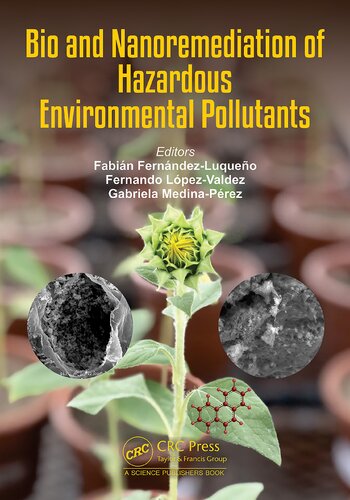Bio and Nanoremediation of Hazardous Environmental Pollutants 1st Edition by Fabian Fernandez Luqueno, Fernando Lopez Valdez, Gabriela Medina Perez 1000954544 9781000954548
$50.00 Original price was: $50.00.$25.00Current price is: $25.00.
Bio and Nanoremediation of Hazardous Environmental Pollutants 1st Edition by Fabian Fernandez Luqueno, Fernando Lopez Valdez, Gabriela Medina Perez – Ebook PDF Instant Download/Delivery: 1000954544, 9781000954548
Full download Bio and Nanoremediation of Hazardous Environmental Pollutants 1st Edition after payment

Product details:
ISBN 10: 1000954544
ISBN 13: 9781000954548
Author: Fabián Fernández Luqueño, Fernando López-Valdez, Gabriela Medina Pérez
This book is a compendium of knowledge about nanomaterials and strategies for bioremediation over hazardous environmental pollutants. The book is divided into 2 sections. Section 1 deals with the polluted environment, where it explains that soil is in serious danger and highlights the primary hazardous pollutants. Besides, this section covers algae, autochthonous, introduced, or genetically modified organisms that are used to degrade hazardous contaminants. In Section 2, Bio- and Nanoremediation are shown through synthesis, green synthesis and molecular farming, and their applications or impacts. Moreover, this discusses bio- and nano-remediation, working together for better performance, organisms, and nanomaterials for environmental remediation.
Bio and Nanoremediation of Hazardous Environmental Pollutants 1st Table of contents:
Section 1
1 The Jeopardized Soil
1 Introduction
2 Background of the Status of Soil
3 Natural and Anthropogenic Threats to the Soil Quality
3.1 Soil quality
3.2 Land-use changes
3.3 Persistent organic pollutants
3.4 Natural threats
4 Modern Strategies to Recover Polluted or Degraded Soils
4.1 Remotion of metals
4.2 Other strategies
5 Some Final Considerations
6 Conclusions
Acknowledgment
References
2 Isoproturon Herbicide Interaction with Crops and Biodegradation
1 Introduction
2 Effect of IPU on Crop
2.1 Photosynthesis
2.2 Oxidative stress
3 IPU Resistance in Crop
4 Uptake and Translocation of IPU in Crops
5 Biodegradation of IPU
6 Metabolic Pathways of Isoproturon
7 Factors Affecting Biotransformation of Isoproturon
8 Conclusion
Acknowledgement
References
3 New Paradigm in Algae-based Wastewater Remediation
1 Introduction
2 Need for Treatment of Wastewater
3 Wastewater Composition
4 Sources and Compositions of Different Wastewaters
4.1 Dairy wastewater
4.2 Textile wastewater
4.3 Winery wastewater composition
4.4 Olive mill wastewater composition
4.5 Piggery wastewater
4.6 Tannery wastewater
4.7 Pulp and paper mill wastewater
4.8 Distillery wastewater
4.9 Agricultural and municipal wastewater
5 Role of Diatoms Algae in Wastewater Remediation
6 Nanoremediation of Wastewater—A New Paradigm
7 Challenges in Wastewater Treatment based on Algae
7.1 Harvesting of algal biomass
7.2 Removal of heavy metals
7.3 Removal of emerging contaminants
8 Conclusion
Acknowledgements
References
4 Microbial Communities and GHG Emissions from Polluted Agricultural Soils Remediated with Several Amendments
1 Introduction
2 Soil Biodiversity
2.1 Soil microorganisms
3 GHG Emissions and Soil Pollution
4 Emission of GHG During the Remediation of Polluted Soils
4.1 Bioremediation of PAH polluted soils
4.2 CO2, CH4, and N2O emissions from soil irrigated with urban wastewater for maize cultivation
5 Application of Carbon Materials or State of the Art Materials to Reduce GHG Emissions
6 Conclusions
Acknowledgements
References
5 Agricultural Nanotechnologies to Improve the Crops’ Quality, Increasing their Yields and Remediating Polluted Soils
1 Introduction
2 Uptake, Movement and Accumulation of Nanosized Materials in Plants
2.1 Foliar uptake and transport
2.2 Root uptake and transport
2.3 Accumulation of NP
3 Interactions of NPs on Plants
3.1 Effects on germination
3.2 Effects on roots
3.3 Effects on plant growth
4 The Nanosized Materials Stimulate Some Physiological Changes in Plants
5 Are Agricultural Nanotechnologies the Way to Feed a Hungry and Polluted World?
5.1 The concept of hunger
5.2 Who is responsible for fainting for hunger?
5.3 To feed hunger without polluting the environment
5.4 Science, technology and sustainable development (nanotechnology)
6 Agricultural Nanotechnologies to Decontaminate the Environment and Feeding Humans Worldwide
7 Remediation of Soils by Nanoparticles
8 Conclusion
Acknowledgements
References
Section 2
6 Genetically Modified Plants for Phytoremediation Biotechnological Microbial Remediants Enhanced Pedospheric Detoxification Accomplished via Transgenic Plants
1 Introduction
2 Methods
2.1 Searching approach
3 Phytoremediation—An Eco-sustainable Detoxification Approach
4 Categorization of Phytoremediation Processes
5 Dead Phyto-mass
6 Phytoremediation with Transgenic Plants
7 Transgenic Plants: Aspects at Cellular and Molecular Levels
8 Transgenics and Environmental Detoxification: Recent Advances
9 Conclusions and Future Perspectives
Conflict of Interest
References
7 Synthesis and Applications of Transition Metal Oxide Nanoparticles for Bacteria Disinfection and Virus Inactivation in the Environment
1 Introduction
2 Synthesis
2.1 Synthesis of tricobalt tetraoxide
2.2 Synthesis of nickel oxide
2.3 Synthesis of copper oxide
2.4 Synthesis of zinc oxide
2.5 Composites
3 Morphological and Structural Characterization of Nanoparticles
4 Applications for Disinfection
4.1 Tricobalt tetraoxide
4.2 Nickel oxide
4.3 Cupric oxide
4.4 Zinc oxide
4.5 Nanocomposite
5 Disinfection Mechanism
6 Virus Inactivation
7 Conclusion
Acknowledgments
References
8 Synthesis of Carbon-based Nanomaterials and their use in Nanoremediation
1 Introduction
1.1 Environmental problems
1.2 Environmental remediation approaches
2 Some Carbon-based Nanomaterials
2.1 Carbon-based nanomaterials and applications
2.2 Fullerenes
2.3 Graphene
2.4 Carbon nanotubes
2.5 Carbon nanofibers
3 Properties of Carbon-based Nanomaterials
3.1 Size, shape, and surface area
3.2 Molecular interactions and sorption characteristics
3.3 Electronic, optical, and thermal characteristics
4 Occurrence, Behavior, Fate and Transport of Carbon-based Nanomaterials in the Environment
4.1 Occurrence of carbon-based nanomaterials in the environment
4.2 Behavior, fate and transport of carbon-based nanomaterials in the environment
5 Synthesis of Carbon-based Nanomaterials
5.1 Synthesis of fullerenes and modified fullerenes
5.2 Synthesis of graphene and graphene-based nanomaterials
5.3 Synthesis of carbon nanotubes
5.4 Synthesis of carbon nanofibers
5.5 Challenges and limitations
6 Use of Carbon-based Nanomaterials in Environmental Remediation
6.1 Carbon-based nanomaterials as adsorbents
6.2 Carbon-based nanomaterials for composite filters
6.3 Carbon-based nanomaterials as water treatment membranes
6.4 Carbon-based nanomaterials as antimicrobial agent
6.5 Carbon-based nanomaterials for photocatalytic approaches
7 Toxicity of Carbon-based Nanomaterials
7.1 Toxicity tests in aqueous solutions
7.2 Toxicity tests based on sediment and soil organisms
8 Discussion and future directions
9 Conclusions
References
9 Green Synthesis of Nanomaterials and their use in Bio-and Nanoremediation
1 Introduction
2 Pollution and Environmental Remediation
2.1 General context of environmental pollution in soil and groundwater
2.2 Environmental remediation
3 Green Nanotechnology
3.1 Principles of green chemistry in nanotechnology
3.2 Green synthesis of nanomaterials
4 Green Synthesized Nanomaterials in Bio- and Nanoremediation Processes
4.1 Metallic nanomaterials
4.2 Metal oxide nanomaterials
4.3 Nanocomposites
5 Limitations and Prospects of Green Nanomaterials in Bio or Nanoremediation
6 Conclusions
References
10 Nanoremediation of Hazardous Environmental Pollutants
1 Introduction
2 Application of Nanomaterials for Nanoremediation
2.1 Carbon based nanostructures in nanoremediation
2.2 TiO2 nanostructures in bio and nanoremediation
2.4 Silica nanomaterials
3 Challenges and the Future of Nanoremediation
References
11 Chemical and Biochemical Process Involved in the Degradation of Hazardous Contaminants through Bio and Nanoremediation
1 Introduction
1.1 Nano-bioremediation
1.2 Nanoremediation
1.3 Bioremediation
2 Removal mechanism of nano, Bio and nano-bioremediation
2.1 Removal mechanism of nanoremediation
2.2 Removal mechanism of bioremediation
2.3 Degradation mechanism of nano-bioremediation (NBR)
3 Process Configuration of Integrated Nano-bioremediation (NBR)
3.1 Sequential method
3.2 Concurrent method
4 Bio-Nanoparticles (BNPs)
5 Nanobioremediation Challenges
5.1 Toxicity
5.2 Disposal
5.3 Reusability
5.4 Sustainability
5.5 Stability
6 Conclusions
References
12 Environmental Remediation by Novel Nanomaterials and Fungi with High-degradation Capacity of Hazardous Contaminants
1 Introduction
2 Fungal Degradation of Pollutants
2.1 Fungal remediation of heavy metals
2.2 Fungal enzymes for remediation of organic pollutants
3 Nanomaterials
3.1 Naturally occurring environmental nanoparticles
3.2 Synthetic (or engineered) nanoparticles
4 Green Synthesis of Nanoparticles by Fungi
4.1 Biosynthesis mechanism
5 Nanoparticles Applied to Remediation
5.1 Use of metal and metal oxide nanoparticles in remediation
5.2 Use of carbon-based nanomaterials in remediation
5.3 Use of nanopolymers in remediation
5.4 Other nanoparticles in bioremediation
5.5 Nanobioremediation
5.6 Nanobiosensors for detection of pollutants
5.7 Nanoparticle toxicity
6 Conclusions, Future Directions and Final Remarks
Acknowledgement
References
13 Nanomaterials and Edible or Nonedible Crops for Dissipate Pollutants Using Nanotechnology to Bioremediate the Environment
1 Introduction
2 Environmental Remediation through Nanotechnologies
3 Synthesis of Novel Materials
3.1 Chemical conventional methods of nanoparticle synthesis
3.2 Green synthesis
3.3 Smart nanomaterials
3.4 Nanohybrids
3.5 Bionanomaterials
3.6 Nanomachines
4 Biotechnologies to Phytoremediate Hazardous Contaminants
5 Novel Materials and Plants Working Together to Dissipate Pollutants
6 Conclusion
Acknowledgments
References
14 Conducting Polymers Based Nanocomposites for the Environmental Pollutants Detection
1 Introduction
2 History
3 Different Types of Environmental Pollutants
3.1 Hydroquinone
3.2 Catechol
3.3 Resorcinol
3.4 Lead
3.5 Cadmium
3.6 Mercury
3.7 Copper
3.8 Nickel
3.9 Chromates
3.10 Pesticides based pollutants
4 Conducting Polymer-based Composites
4.1 Polyaniline based composites
4.2 Polypyrrole based composites
4.3 Poly (Ethylene dioxythiophene) based composites
4.4 Polythiophene based composites
5 Conclusion with Future Scope
References
Index
People also search for Bio and Nanoremediation of Hazardous Environmental Pollutants 1st:
bio regrow side effects
bio-fen plus side effects
bioremediation and bacteria
bioremediation and bioaugmentation
Tags:
Fabian Fernandez Luqueno,Fernando Lopez Valdez,Gabriela Medina Perez,Nanoremediation
You may also like…
History - Military History
Uncategorized
Languages - English as a Foreign Language & Reference
English Grammar Exercises with answers Part 4 Your quest towards C2 1st Edition Daniel B. Smith
History - Military History
History - Military History
Housekeeping & Leisure - Games: Chess
Housekeeping & Leisure - Games: Chess











